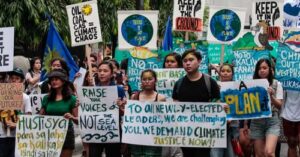The mining industry is now on overdrive after the Supreme Court (SC), contrary to expectations, threw out the mining moratorium imposed by Occidental Mindoro and Abra de Ilog town in 2009. The 31-page verdict, promulgated on Jan. 14, 2025 but released after the mid-term elections, ruled that the provincial government “exceeded” its authority by banning all large-scale exploration, quarrying and mining operations for 25 years.
In ruling against Occidental Mindoro and in favor Ramon Ang and his Agusan Petroleum and Mining Corp. (APMC), the SC decision written by Associate Justice Marvic Leonen (who hails from the Cordillera) stressed the exercise of powers by local government units (LGUs) must be consistent with the provisions of Republic Act No. 7942, or the Philippine Mining Act of 1995 pushed by the late President Fidel V. Ramos. APMC filed the case against Occidental Mindoro before the Mamburao Regional Trial Court (RTC) in 2014, arguing that the ban was “unreasonable, oppressive and discriminatory” and won in 2018, forcing the provincial government to appeal.
Ang secured a deal with the province in 2008, a year before the moratorium was imposed. Ang, the San Miguel Corp. (SMC) head honcho and fair-haired boy of Danding Cojuangco, sued as he had no truck with the ban and was obsessed with transforming SMC from a food-and-beverage giant into a monster conglomerate covering mining, banking, infrastructure development, tollways operations, agribusiness ventures from poultry to crop production, airport development and management, power generation and even eco-tourism ventures (to justify trumping agrarian reform in Bugsuk Island.)
While Ang is obviously the big winner with the Leonen ponencia, other mining bigwigs like the Zamora brothers are also gloating, celebrating the decision as manna from heaven. The ruling in GR 248932 practically transforms Ang into one of the country’s biggest landlords, competing with the Consunjis and the Villars, as he can now invoke the Leonen decision to proceed with explore, mine and export minerals from 46,050 hectares of land covered by his mining tenement in Baco, San Teodoro and Puerto Galera in Oriental Mindoro and in Mamburao City and Abra de Ilog in Occidental Mindoro.
If the continuing talk about the unexplored riches of Mindoro Island were to be considered, the SC ruling would see an avalanche of mining applications inasmuch as the island had long been considered by geologists as the oldest land formation in the archipelago. Russian geologists who prospected in Mindoro talked about the possibility of substantial uranium deposits, much like the theory of precious minerals in the interior of Samar Island. In no time, there will be a flood of mining claims and a deluge of corporations, local or foreign, salivating more mineral ores. Ang’s APMC was looking for huge veins of gold and silver in Mindoro as his tenement covers the two Mindoro provinces, each of which could potentially throw a monkey wrench into his mining exploration.
Lawyers are fond of saying that when the SC commits an error, it becomes part of the law of the land. Would the distinguished jurists lament, or would they continue to hide their heads in the sand the way they did when they interpreted the partylist law to allow representation of the overrepresented, which means the further marginalization of the grievously marginalized? Or like the Comelec, which junked a disqualification case against the Tulfos as the complaining lawyer committed a tragic procedural error like failing to submit certificates of candidacy (COC) of the Tulfos. Similarly, fraud committed by Erwin Tulfo in his application for US citizenship, passport and visa (forged birth certificates cannot be aboveboard) does not mean fraud under Philippine law) and so Malacanang’s favored Senate bet was not disqualified.
The people of Occidental Mindoro may just as well collaborate with the people of Isabela who have condemned the Zamora-owned Dinapigue Mining Corp. (DMC) in Dinapigue, Isabela, for denuding the forests within the Northern Sierra Madre Natural Park (NSMNP), which covers of 287,861 hectares (711,320 acres) of land and 71,652 hectares (177,060 acres) of coastline water area in the Isebala towns Palanan, Divilacan and Maconacon, San Mariano, Dinapigue, San Pablo, Cabagan, Tumauini and Ilagan City. The Sierra Madre is the longest mountain range in the Philippines and shields much of Luzon from destructive typhoons. It is home to at least nine threatened animal species and eight rare plants, all of which will become extinct as mining exploration disturbs their habitat, with the rare animals pushed into the vanishing interior. The people of Palawan, long harassed by Ang and his companies and the mining firms of the Zamoras, would gladly work with them to oppose destructive mining.
For its part, the Kalikasan People’s Network for the Environment (K-PNE) said the SC decision “tramples on the right of local governments and communities to defend their environment and welfare.” SC justices are a light-year removed from communities and LGUs that face all the environmental risks caused by destructive mining operations, K-PNE argued. They are ensconced in their chambers unaware of the perils caused by their pro-mining rulings. They will not suffer the consequences of their judicial folly. Neither will Ramon Ang, Nickel Asia and the Zamoras feel the impact of their profit-making mining operations for the benefit of China and other wealthy countries. Yet, they talk of sustainable mining and protecting the environment. Remember the late American poet and activist Lawrence Ferlinghetti, who, echoing Kahlil Gibran, wrote: “Pity the nation oh pity the people///who allow their rights to erode///and their freedoms to be washed away///My country, tears of thee///Sweet land of liberty!”




